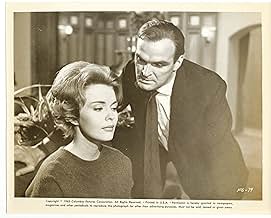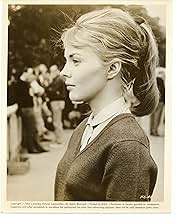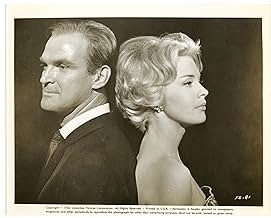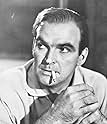अपनी भाषा में प्लॉट जोड़ेंA young American art student must decide whether to stay in Paris with her boyfriend or go back to the U.S. when her wealthy father arrives to bring her back.A young American art student must decide whether to stay in Paris with her boyfriend or go back to the U.S. when her wealthy father arrives to bring her back.A young American art student must decide whether to stay in Paris with her boyfriend or go back to the U.S. when her wealthy father arrives to bring her back.
Barbara Sommers
- Madame Piguet
- (as Barbara Somers)
James Leo Herlihy
- Dr. John Haislip
- (as James Herlihy)
Claudine Auger
- Clio Andropolous
- (बिना क्रेडिट के)
Jacques Charon
- Patrini
- (बिना क्रेडिट के)
Michel Wyn
- Man with dark glasses in the bar
- (बिना क्रेडिट के)
फ़ीचर्ड समीक्षाएं
Wow, despite following Seberg a bit I had never heard of this movie and found it wonderful. I'm a sucker for films about Americans in Europe between the end of the war and before the hippies. Seberg is so desirable (gosh, she looks a lot like Tippi Hedren here) -- people seemed so much more adult at a much younger age. (I recall that line from You've Got Mail where Parker Posey says, Do you believe the Rosenbergs in the picture were around our age?). Always when viewing these films about young women in the late Fifties/early Sixties, I find it poignant to think about them, and how their lives may be changed by the upheavals of the late Sixties. And, of course, that's true of Seberg. Anyway, the movie is a treat -- watch it.
Beautiful young Jean Seberg (as Christina James) leaves Chicago for Paris, to study painting. There, she meets beautiful young student Philippe Forquet (as Guy), who sits for a portrait. After a few months of dating, Mr. Forquet proposes he and Ms. Seberg have sex. Although she loves him, Seberg is reluctant, and wants to concentrate on forwarding her career; she dreams of becoming the next "Renoir, Matisse, (or) Picasso." Seberg and Forquet try to forge a relationship, but he has a secret. Seberg encounters other men with problems, like reporter Stanley Baker (as Walter Beddoes). Or, is Seberg, herself, the problem?
Robert Parrish's "In the French Style" features excellent black-and-white location photography, by Michel Kelber. The performances are wonderful, and Seberg's carries the film, which loses direction after, to quote, "the years pass quickly," in Paris. This film is almost perfectly divided into two separate stories. The first part, with Seberg and Forquet, is the best. The story falls apart after Seberg's character becomes a modern day "Camille" - for too many minutes into the new drama, you're wondering what happened to the endearing (and extremely beautiful looking) young couple you've been following so far
Forquet makes an additional, brief appearance. His main replacement, Mr. Baker, is given no opportunity to match the romantic build-up of Seberg and Forquet, which hurts the film considerably. After the important, mostly off-screen relationship with Baker gets going, the story switches gears to focus on the arrival of Seberg's father, Addison Powell, in Paris. Father Powell wants Seberg to give up "the life you lead" (meaning men and parties) and return to a more ordinary life in Chicago. Seberg has to make a decision about her future when Baker's (news correspondent) job takes him to the Middle East (a war zone).
Seberg, who ended her life tragically in 1979, should have played "Camille"; she, like the movie, appears so full of potential. Forquet, who really has a handle on his character's age, is exceptional; unfortunately, he began disappearing after "The Young Rebels" (1970). Surprisingly, Powell appeared on TV's "Dark Shadows" (1968); as "Dr. Lang", he temporarily cured Barnabas Collins of vampirism. Fortunately, Baker went directly into lead roles that took better advantage of his worth, like "Zulu" (1964).
******* In the French Style (9/18/63) Robert Parrish ~ Jean Seberg, Philippe Forquet, Addison Powell, Stanley Baker
Robert Parrish's "In the French Style" features excellent black-and-white location photography, by Michel Kelber. The performances are wonderful, and Seberg's carries the film, which loses direction after, to quote, "the years pass quickly," in Paris. This film is almost perfectly divided into two separate stories. The first part, with Seberg and Forquet, is the best. The story falls apart after Seberg's character becomes a modern day "Camille" - for too many minutes into the new drama, you're wondering what happened to the endearing (and extremely beautiful looking) young couple you've been following so far
Forquet makes an additional, brief appearance. His main replacement, Mr. Baker, is given no opportunity to match the romantic build-up of Seberg and Forquet, which hurts the film considerably. After the important, mostly off-screen relationship with Baker gets going, the story switches gears to focus on the arrival of Seberg's father, Addison Powell, in Paris. Father Powell wants Seberg to give up "the life you lead" (meaning men and parties) and return to a more ordinary life in Chicago. Seberg has to make a decision about her future when Baker's (news correspondent) job takes him to the Middle East (a war zone).
Seberg, who ended her life tragically in 1979, should have played "Camille"; she, like the movie, appears so full of potential. Forquet, who really has a handle on his character's age, is exceptional; unfortunately, he began disappearing after "The Young Rebels" (1970). Surprisingly, Powell appeared on TV's "Dark Shadows" (1968); as "Dr. Lang", he temporarily cured Barnabas Collins of vampirism. Fortunately, Baker went directly into lead roles that took better advantage of his worth, like "Zulu" (1964).
******* In the French Style (9/18/63) Robert Parrish ~ Jean Seberg, Philippe Forquet, Addison Powell, Stanley Baker
Adapted by Irwin Shaw based on two of his novels, Robert Parrish's vehicle for American actress famous for French films Jean Seberg in IN THE FRENCH STYLE also feels like two movies in one involving two polar opposite romances...
The first with a young and opinionated French local Phillipe Forquet whose uptight, idealistic persona contrasts his innocent boyish looks, and it's unbelievable that Seberg's Christina James... an American on perma-vacation in Paris to become an artist... would have lasted in this relationship for a narrated three months, wherein the best aspects are the actual Paris exterior locations...
Meanwhile the following more grown-up half is mostly shot indoors, from apartment rooms to restaurants to a loud jazzy artsy shindig where the best sequence occurs before Christina's second romance with roving reporter Stanley Baker who, like hedonistic playboy Jack Hedley, treats her with respect but no love, which makes the casting of such a perfectly gorgeous ingenue seem all wrong...
But she hits the right notes when her progressive father visits... their one major sequence as Addison Powell's Mr. James tells Christina exactly what she needs not wants to hear is more interesting than all the sweet-nothings by those random suitors, that not only don't deserve her company but hardly fit the movie...
At least not the one starring Jean Seberg, who often seems like she's being visited by various actor-friends on the set of a much deeper, richer and more intriguing art film than IN THE FRENCH STYLE, which attempts both avant garde detachment and mainstream melodrama while partially failing, twice...
But backed by gorgeous B&W French-travelogue-style cinematography, this particular STYLE is like a moving postcard that's very nice to look at... particularly Seberg, at her most beautiful here: And that's saying something.
The first with a young and opinionated French local Phillipe Forquet whose uptight, idealistic persona contrasts his innocent boyish looks, and it's unbelievable that Seberg's Christina James... an American on perma-vacation in Paris to become an artist... would have lasted in this relationship for a narrated three months, wherein the best aspects are the actual Paris exterior locations...
Meanwhile the following more grown-up half is mostly shot indoors, from apartment rooms to restaurants to a loud jazzy artsy shindig where the best sequence occurs before Christina's second romance with roving reporter Stanley Baker who, like hedonistic playboy Jack Hedley, treats her with respect but no love, which makes the casting of such a perfectly gorgeous ingenue seem all wrong...
But she hits the right notes when her progressive father visits... their one major sequence as Addison Powell's Mr. James tells Christina exactly what she needs not wants to hear is more interesting than all the sweet-nothings by those random suitors, that not only don't deserve her company but hardly fit the movie...
At least not the one starring Jean Seberg, who often seems like she's being visited by various actor-friends on the set of a much deeper, richer and more intriguing art film than IN THE FRENCH STYLE, which attempts both avant garde detachment and mainstream melodrama while partially failing, twice...
But backed by gorgeous B&W French-travelogue-style cinematography, this particular STYLE is like a moving postcard that's very nice to look at... particularly Seberg, at her most beautiful here: And that's saying something.
She was a very gifted actress, discovered by Otto Preminger and made all kinds of roles, from Saint Joan to a gangster bride of Jean-Paul Belmondo in Jean-Luc Godard's major debut "A bout de souffle" and with Peter Sellers in one of his best comedies, her second marriage was with Roman Gary, who after her death by suicide at 40 blamed the FBI for it for having hounded her by spreading false rumours, but as an actress she was always outstanding. This is a totally different kind of film. Her character and performance here reminds you of Audrey Hepburn in her very subtle and sensitive, and vulnerable style, and the story is a romantic melodrama about love relationships in Paris, and you must regret that Stanley Baker, always excellent in his crude way, didn't get her. It is a wonderful suave and rather melancholy film like a novelletta, and the music is exquisite.
"You're going to say that I ought to leave Paris...that I ought to come home like a good little girl and be a nice, demure, hypocritical piece of merchandise on the marriage market...pretending I don't know which end of a man is up!" Jean Seberg stars as a 19-year-old girl from Chicago, studying art in Paris and beginning to show real promise, who abandons her talent for an unfulfilled modeling career and a series of romantic misfires; four years later, she's contemplating her future, fed up with the empty decadence, disappointment and heartache of her life. Irwin Shaw based his screenplay on two of his short stories, and he just about nails the insecure feelings of a directionless young woman desperate to hang on to her youth and beauty while seeking loftier paths in the bargain. The film is slowly paced but never dreary, nor insubstantial; it sneaks up on you. Seberg is tentative in her role, but also thoughtful and complicated. It's a Beautiful People movie, likely aimed at upscale female audiences of the time, yet it has a lot more resonance (and cool style) than most other "woman's pictures" of the era. *** from ****
क्या आपको पता है
- ट्रिवियाThis was the first and only feature film to be produced by the eminent writer Irwin Shaw (although he later produced a documentary film). Shaw had expressed loud and frequent dissatisfaction with earlier films based on his work (although the then-anonymous critic of "Time" magazine accused him of "crying into his champagne"), and decided that this screenplay, which he had adapted from two of his own short stories, would be protected if he produced the film himself, with his close friend Robert Parrish directing. The film was well-received by critics - though not the "Time" writer, who said that, if Shaw carried on like this, he would soon be "crying into his beer".
- कनेक्शनReferenced in You Must Remember This: Jean vs "Lilith" (Jean & Jane Part 4) (2017)
टॉप पसंद
रेटिंग देने के लिए साइन-इन करें और वैयक्तिकृत सुझावों के लिए वॉचलिस्ट करें
विवरण
- रिलीज़ की तारीख़
- कंट्री ऑफ़ ओरिजिन
- भाषाएं
- इस रूप में भी जाना जाता है
- Al estilo francés
- फ़िल्माने की जगहें
- उत्पादन कंपनियां
- IMDbPro पर और कंपनी क्रेडिट देखें
बॉक्स ऑफ़िस
- बजट
- $7,50,000(अनुमानित)
- चलने की अवधि1 घंटा 45 मिनट
- रंग
- पक्ष अनुपात
- 1.66 : 1
इस पेज में योगदान दें
किसी बदलाव का सुझाव दें या अनुपलब्ध कॉन्टेंट जोड़ें





























